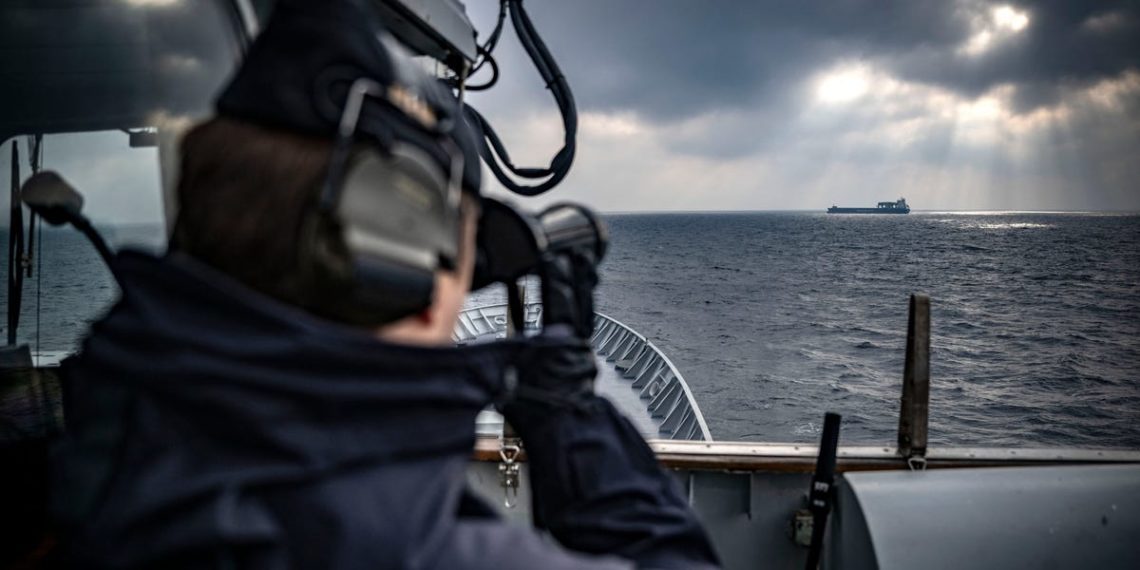
US Marine Corps photo by Lance Cpl. Alexandria Serrano
- NATO’s Baltic Sea security mission has cut down on undersea sabotage, Western officials said Friday.
- The alliance deployed forces to the region in January following a series of concerning incidents.
- Some of the malign activity has been linked to Russia and described as a hybrid campaign.
NATO’s security operation to protect critical undersea infrastructure in the Baltic Sea, now several months into the mission, appears to be driving down sabotage incidents, Western officials told Business Insider on Friday.
“For the last half year, we haven’t had any incidents,” Commodore Arjen Warnaar, the Dutch commander of Standing NATO Maritime Group 1, said during an interview.
“My feeling is that we are having an effect,” he said.
Warnaar spoke aboard the Dutch warship HNLMS Johan de Witt, the flagship of SNMG1, an alliance naval quick reaction force. The amphibious transport vessel arrived in London on Friday, fresh off a deployment participating in NATO’s Baltic Sentry mission.
NATO announced the mission in January following several incidents involving sabotage of critical undersea infrastructure in the Baltic Sea. Some of the malign activity has been linked to Russia and attributed to an ongoing hybrid warfare-style campaign that officials argue Moscow is waging against the West.
Throughout the year, NATO warships and aircraft have patrolled the region to prevent further damage from sabotage.

JOHAN NILSSON/TT NEWS AGENCY/AFP via Getty Images
Though Baltic Sentry is an alliance effort, Warnaar specifically praised Baltic Sea states like Sweden, Finland, and Estonia, that have been more heavily involved in deterring sabotage given that the stakes are higher for these countries. The damage of data and communication cables has a greater effect on them.
“The hardest part is actually the legal part, and the coastal states in the Baltic have done a fantastic job to address this,” Warnaar said. “NATO is always there. We’re monitoring, we’re watching, and we are reporting everything we see, and that is an important function.”
Cdr. Craig Raeburn, the British chief of staff for SNMG1, said aboard the Johan de Witt, that over the year, NATO has increased its surveillance and reaction capability within Baltic Sentry.
“The reaction time to any kind of malign incident in the Baltic was probably about seven to eight hours before we got any kind of surveillance or understood what was going on,” he said. “And I think now it’s probably down to an hour.”
Raeburn said that NATO uses artificial intelligence technology to analyze shipping patterns for any unusual activity, including strange turning motions, loitering, and notable changes in speed that might be normal for a warship but not a civilian vessel.

HENRY NICHOLLS/AFP via Getty Images
If the AI detects any unusual activity, NATO commanders can quickly deploy drones, aircraft, or ships to the area to investigate. Raeburn said that it looks like “because we started looking and we started reacting,” the sabotage has disappeared.
NATO added more assets to Baltic Sentry in late September following drone incursions over Danish military bases.
Cdr. Arlo Abrahamson, a spokesperson for NATO’s Allied Maritime Command, said at the time that the deployment of additional support and patrol assets — including multiple intelligence, surveillance, and reconnaissance platforms, and at least one air defense frigate — demonstrates how Baltic Sentry is a flexible mission with “more to it than just the protection of critical undersea infrastructure.”
Baltic Sentry is taking place alongside Eastern Sentry, another NATO mission aimed at shielding the alliance’s eastern edge. It launched in mid-September after European forces shot down a number of Russian drones that violated Polish airspace.
Several countries have deployed fighter jets to Eastern Sentry to help patrol NATO airspace over the past few weeks.
Read the original article on Business Insider
The post NATO’s Baltic Sea patrol surge and much faster reaction time are driving down undersea sabotage, Western officials say appeared first on Business Insider.




